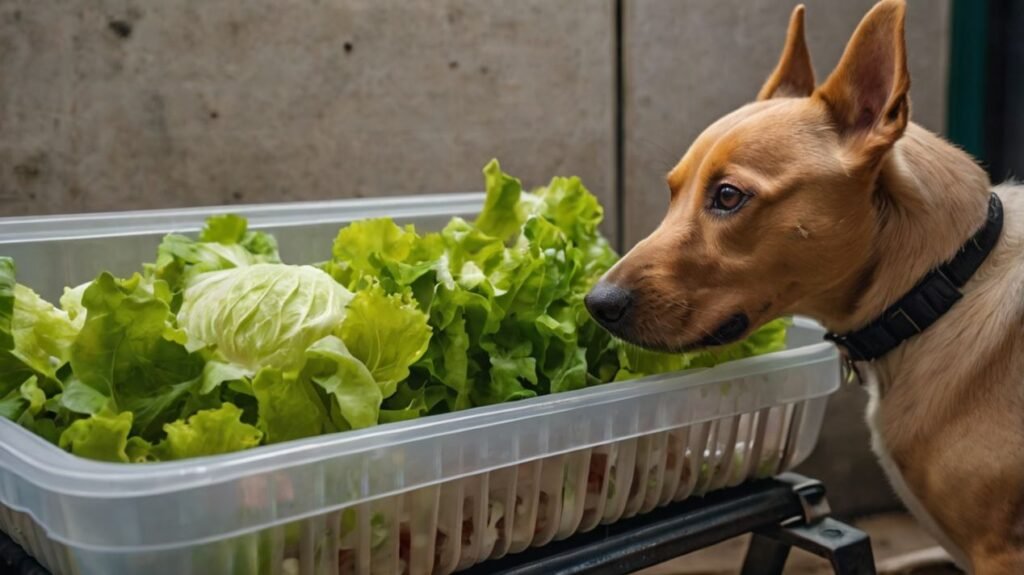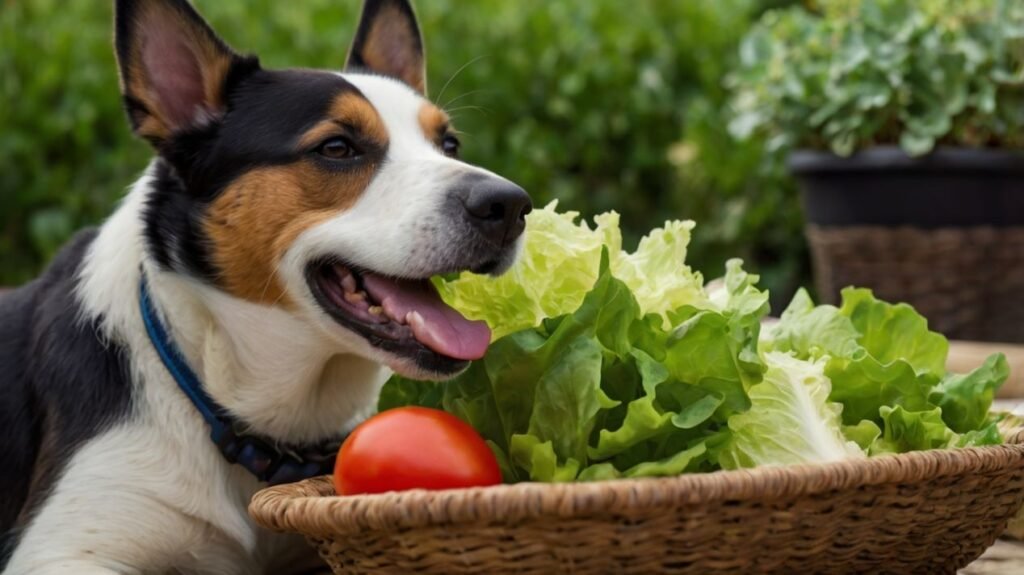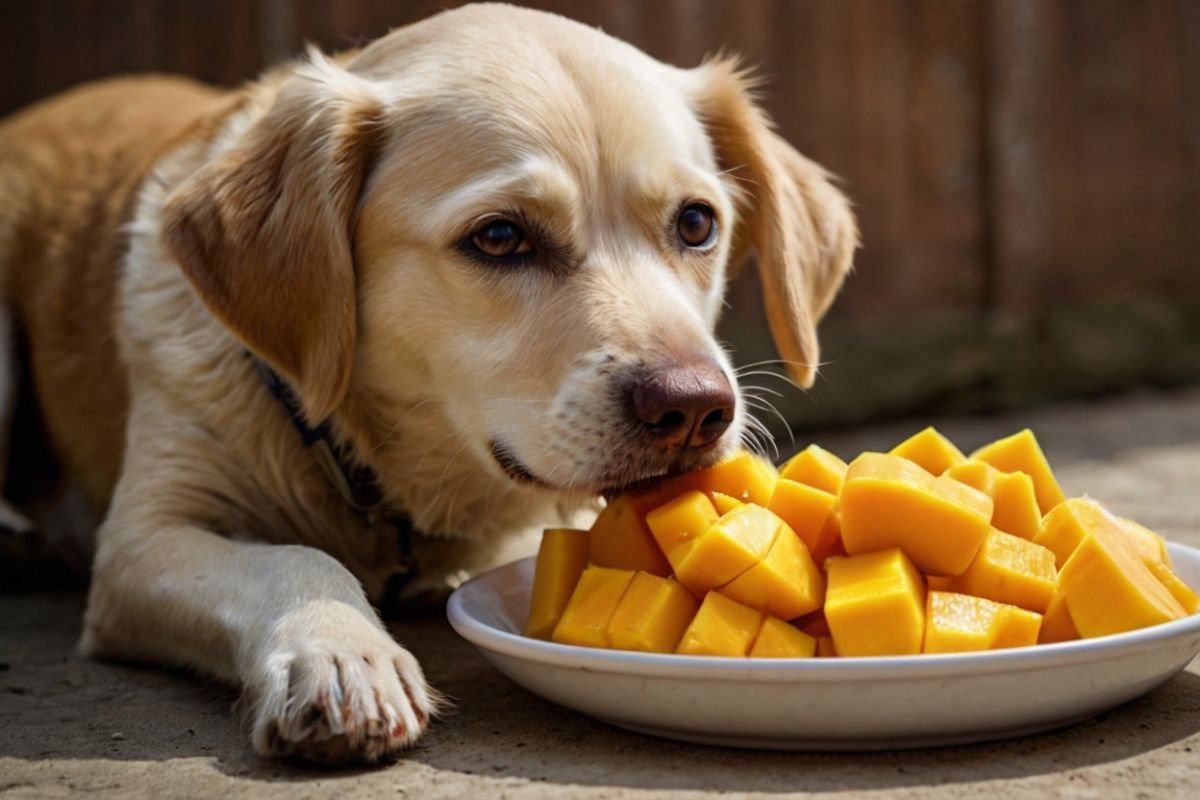I’ll never forget the first time I caught my dog staring at my Caesar salad. Those big, hopeful eyes seemed to say, “Hey, what about me?” Like most dog parents, I wanted to share something healthy with my furry buddy. But then came that familiar worry – is this actually safe?
If you’re reading this, you’ve probably had the same moment. Maybe you were chopping lettuce and dropped a piece. Your dog gobbled it up before you could stop them. Now you’re wondering if you should panic or not.
Well, I’ve got good news for you! After years of research and talking with my vet, I can tell you that yes – dogs can eat lettuce. But there’s definitely a right way and a wrong way to do it.
I’ve learned so much about this topic over the years. Today, I want to share everything I know with you. By the time you finish reading, you’ll feel confident about whether lettuce belongs in your dog’s treat rotation.

Table of Contents
Why I Started Giving My Dog Lettuce
Honestly, it happened by accident. I was making lunch one day when a piece of romaine fell on the floor. Before I could pick it up, my dog crunched it down happily. I panicked and called my vet immediately.
“Relax,” she laughed. “Lettuce is totally fine for dogs. It’s mostly water anyway.” That conversation changed everything for me. Suddenly, I had a new healthy treat option.
What I love most about lettuce is how simple it is. No cooking required. No weird ingredients to worry about. Just wash it, chop it up, and you’re done. Plus, my dog actually seems to enjoy the crunch.
Over time, I’ve noticed some real benefits. My dog stays more hydrated during summer walks. I have a guilt-free training treat that won’t pack on pounds. And let’s be honest – it’s way cheaper than those fancy store-bought treats.
Also read, Can Dogs Eat Okra?
The Science Behind Why Lettuce Works for Dogs
Now, I’m not a vet, but I’ve done my homework on this. Lettuce is about 95% water, which makes it super low in calories. We’re talking maybe 5 calories per cup. Compare that to most dog treats, and you’ll see why I got excited.
Here’s what makes lettuce safe for our pups. Unlike onions or chocolate, lettuce doesn’t contain anything toxic to dogs. It’s just water, fiber, and a few vitamins. Nothing scary or complicated.
The water content is actually a huge plus. I live in a hot climate, so anything that helps keep my dog hydrated is a win. During summer, I sometimes freeze small lettuce pieces in ice cubes. My dog thinks it’s the best thing ever.
However, I learned the hard way about moderation. The first time I gave lettuce, I went overboard. Let’s just say we had some digestive drama later that day. Now I stick to small amounts, and everything’s perfect.
My Experience with Different Types of Lettuce
Not all lettuce is created equal – trust me on this one. I’ve tried them all with my dog over the years. Here’s what I’ve learned:
Iceberg Lettuce: The Safe Choice
This was my starting point, and honestly, it’s still my go-to. Iceberg has the most water and least fiber. That means it’s the gentlest on sensitive tummies. My dog loves the satisfying crunch it makes.
Sure, it’s not packed with nutrients like kale or spinach. But sometimes simple is better. When I want a no-fuss treat that I know won’t cause problems, iceberg is my choice.
Romaine: The Nutritious Option
Once my dog got used to iceberg, I tried romaine. It has more vitamins and a different texture. My dog seemed to prefer the sturdier leaves – maybe because they’re more fun to crunch?
But I noticed romaine has more fiber. That means smaller portions are necessary. I learned this lesson after being a bit too generous one evening. Let’s just say I was cleaning up messes for a while.
Butter Lettuce: The Gentle Alternative
When my dog was recovering from a stomach bug, my vet suggested butter lettuce. The leaves are so soft and mild. It was perfect for getting some nutrition without upsetting a sensitive system.
I still use butter lettuce when my dog seems to have an off day. The tender leaves seem easier to digest. Plus, it’s less likely to get stuck in teeth or cause choking.
What I’ve Learned About Leaf Lettuce
Green and red leaf varieties work well too. They’re somewhere between iceberg and romaine in terms of texture and nutrition. My dog doesn’t seem to have a preference between colors, which makes shopping easier.
The key with any variety is starting slow. I always introduce new types gradually. Even if my dog handles iceberg perfectly, that doesn’t guarantee success with other types.
The Mistakes I Made (So You Don’t Have To)
Looking back, I definitely made some rookie errors when I first started giving lettuce to my dog. Let me share these so you can avoid the same problems.
Mistake #1: Too Much, Too Fast
My biggest mistake was getting too excited about this new healthy treat. I gave my dog way too much on the first try. The result? A very unhappy stomach and a mess to clean up.
Now I know better. Start with just a few tiny pieces. See how your dog handles it. If all goes well, you can gradually increase the amount. But “gradually” means over several weeks, not several days.
Mistake #2: Not Washing Properly
I’ll admit it – I was lazy about washing lettuce at first. I figured a quick rinse was enough. Then my dog got a mild stomach upset, and my vet reminded me about bacteria on leafy greens.
Now I wash every single leaf individually under running water. It takes a few extra minutes, but it’s worth the peace of mind. I also buy organic when possible to reduce pesticide exposure.
Mistake #3: Ignoring Choking Hazards
Large pieces of lettuce can ball up in a dog’s throat. I learned this when my dog started coughing after eating a big piece of romaine. Thankfully, it worked itself out, but I was terrified.
These days, I cut everything into small, manageable pieces. For my dog’s size, that means pieces no bigger than my thumbnail. It might seem excessive, but better safe than sorry.
Mistake #4: Not Watching for Reactions
In the beginning, I’d give lettuce and then go about my day. I wasn’t paying attention to how my dog responded. This meant I missed some early warning signs of digestive sensitivity.
Now I always observe my dog for at least a few hours after trying any new food. I look for changes in behavior, appetite, or bathroom habits. Catching problems early makes them much easier to handle.
How I Prepare Lettuce for My Dog
After all my trial and error, I’ve developed a system that works perfectly. Here’s my step-by-step process:
My Washing Routine
First, I remove any wilted or damaged outer leaves. These can harbor bacteria and aren’t appetizing anyway. Then I separate all the remaining leaves and rinse each one individually under cool running water.
I pay special attention to the base where dirt tends to collect. Sometimes I soak the leaves for a few minutes if they seem particularly dirty. After washing, I pat everything dry with clean paper towels.
Cutting and Sizing
This part depends on my dog’s size and eating style. I cut pieces small enough that they can’t cause choking but big enough to provide some satisfying crunch. Usually, that means pieces about the size of my dog’s regular kibble.
I always remove thick stems or ribs. These parts are harder to digest and more likely to cause problems. I focus on the tender, leafy portions that my dog enjoys most.
Storage Tips
If I’m prepping ahead of time, I store the clean, cut lettuce in the refrigerator. I use it within a day or two for best freshness. Sometimes I portion it into small containers so I can grab a quick treat easily.
For special occasions, I freeze small pieces in ice cube trays with a little water. These frozen treats are perfect for hot summer days. My dog goes crazy for them.
What I’ve Learned About Portions
Figuring out the right amount took some experimentation. Here’s what works for my dog and what I’ve learned from other dog parents:
Size Matters
My dog is medium-sized, around 40 pounds. For him, I stick to about 4-6 small pieces of lettuce per serving. When I had a smaller foster dog, I cut that in half. Bigger dogs can handle a bit more.
The key is remembering that lettuce should be a treat, not a meal replacement. Even though it’s healthy, it doesn’t provide complete nutrition like regular dog food does.
Frequency Guidelines
I offer lettuce maybe 2-3 times per week at most. Any more than that, and I worry about upsetting the balance of my dog’s regular diet. Plus, variety is good – I like to rotate different healthy treats.
During training sessions, I might use tiny pieces more frequently. But I always adjust meal portions accordingly. The 10% treat rule applies even to healthy options like lettuce.
Seasonal Adjustments
I tend to offer more lettuce during hot summer months when the extra hydration is beneficial. In winter, I might skip it for weeks at a time. There’s no need to force it if my dog isn’t interested or doesn’t need the extra moisture.
Signs I Watch For

Over the years, I’ve become pretty good at reading my dog’s reactions to new foods. Here’s what I look for when introducing lettuce or increasing portions:
Good Signs
When things go well, my dog acts normally. He might drink a little more water than usual because of the fiber, but that’s expected. Sometimes he gets more interested in vegetables after having lettuce, which I consider a bonus.
I also notice that lettuce seems to satisfy his need to chew without adding calories. This is especially helpful during training sessions when I need lots of small rewards.
Warning Flags
The main things I watch for are digestive upset symptoms. These include vomiting, diarrhea, excessive gas, or loss of appetite. Usually, these happen within 24 hours if they’re going to happen at all.
I also pay attention to behavior changes. If my dog seems uncomfortable, restless, or is drinking way more water than normal, I take note. These can be subtle signs that something isn’t agreeing with him.
When I Call the Vet
Thankfully, I’ve never had a serious problem with lettuce. But I know I’d call my vet if I saw signs of an allergic reaction like facial swelling, difficulty breathing, or severe skin irritation.
I’d also call if digestive symptoms persisted beyond a day or seemed severe. While lettuce problems are rare, it’s always better to be cautious when it comes to our pets’ health.
Alternatives I’ve Tried
Not every dog loves lettuce, and that’s okay. Over the years, I’ve discovered other great options for dogs who want something crunchy and healthy:
Other Vegetables That Work
Carrots are fantastic – my dog loves the sweetness and crunch. Green beans provide similar benefits to lettuce but with more substance. Cucumber is another high-water option that works well.
I’ve also had success with small pieces of bell pepper. The bright colors seem appealing, and they’re packed with vitamins. Sweet potato (cooked and cooled) is more of a special treat but very popular.
Fruit Options
When I want something extra special, I offer small pieces of apple (no seeds) or a few blueberries. Watermelon is perfect for summer – it’s like lettuce but sweeter. My dog thinks he’s getting dessert.
However, I’m always careful to research any new fruit. Some, like grapes, are absolutely off-limits for dogs. When in doubt, I stick to options I know are safe.
Store-Bought Alternatives
Sometimes convenience wins, and I use commercial healthy treats. I look for options with simple ingredients and no artificial additives. Freeze-dried vegetables are a good middle ground between fresh and processed.
There are also commercial treats specifically designed for weight management. These can be helpful for dogs who need to watch their calories but still want something tasty.
Special Situations I’ve Encountered
Puppy Considerations
When I fostered a young puppy, I had to adjust my approach completely. Puppies have much more sensitive digestive systems. I started with just one tiny piece of lettuce and watched carefully for reactions.
Also, puppies need calorie-dense foods for proper growth. Lettuce shouldn’t take up space that could be filled with nutritious puppy food. I used it very sparingly and only as an occasional novelty.
Senior Dog Needs
My dog is getting older now, and I’ve noticed some changes in how he handles different foods. His digestion seems more sensitive, so I stick to softer lettuce varieties like butter lettuce.
The low-calorie aspect is even more important now that he’s less active. Lettuce helps him feel like he’s getting treats without packing on extra weight that could stress his aging joints.
Dogs with Health Issues
I’ve known dogs with diabetes, kidney problems, and other conditions who needed special dietary considerations. For these situations, I always recommend checking with a vet before introducing any new foods, even something as simple as lettuce.
Some medications can interact with foods high in certain vitamins. While lettuce is generally safe, it’s better to be cautious when dealing with health conditions.
Making Lettuce Fun and Interesting
After years of giving lettuce, I’ve gotten creative with how I serve it. Here are some ideas that have been hits:
Training Treats
Lettuce pieces work great for training because they’re small, low-calorie, and make a satisfying crunch. I cut them extra tiny for rapid-fire training sessions. My dog works just as hard for vegetable treats as he does for commercial ones.
Puzzle Games
I hide lettuce pieces in snuffle mats or puzzle toys. This turns treat time into mental stimulation time. My dog has to work for his reward, which makes it more satisfying for both of us.
Frozen Summer Treats
During hot weather, I freeze lettuce pieces in ice cube trays with a little water. Sometimes I add other safe ingredients like small pieces of apple or carrot. These frozen treats provide cooling relief and entertainment.
Treasure Hunts
On nice days, I scatter tiny lettuce pieces around our fenced yard. My dog loves the treasure hunt aspect, and it combines treat time with exercise. Just make sure your yard is secure and free from hazards.
What My Vet Has Taught Me
Over the years, my vet has shared some valuable insights about dogs and vegetables. She emphasized that while treats like lettuce are fun, they should never replace a balanced, complete dog food.
She also reminded me that every dog is different. What works perfectly for my dog might not suit another dog at all. That’s why starting slowly and watching for reactions is so important.
One thing that stuck with me was her advice about variety. She said rotating different healthy treats is better than sticking to just one option. This prevents boredom and reduces the risk of developing sensitivities.
My Final Thoughts on Dogs and Lettuce
After years of experience, I can confidently say that lettuce has been a great addition to our treat routine. It’s simple, healthy, and my dog genuinely enjoys it. But success comes from doing it right.
The key points I want you to remember are: start small, watch for reactions, and keep it as an occasional treat. Don’t overthink it, but don’t be careless either. Trust your instincts as a dog parent.
If you’re still unsure, talk to your vet. They know your dog’s specific health situation and can give personalized advice. There’s no shame in asking questions – that’s what makes us good pet parents.
Remember, every dog is unique. Your experience might be different from mine, and that’s perfectly normal. Pay attention to your own dog’s preferences and reactions. They’ll let you know if lettuce is right for them.
Most importantly, enjoy these little moments of sharing healthy foods with your furry friend. These simple acts of love and care are what make the bond between dogs and humans so special. Whether it’s lettuce or any other treat, the joy comes from sharing these experiences together.

Shahriar Robin is the creator of WhatPetsCanEat.com, a passionate pet lover and dedicated cat dad to Rio, a curious two-year-old orange feline who inspired this website. With a love for animals and a knack for research, Shahriar shares trusted, easy-to-understand information to help fellow pet owners make safe, healthy food choices for their furry friends.


